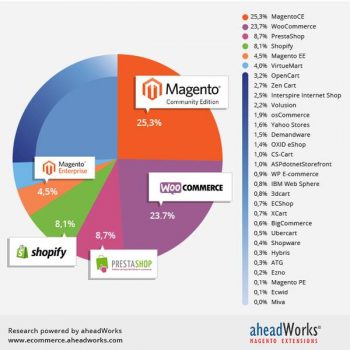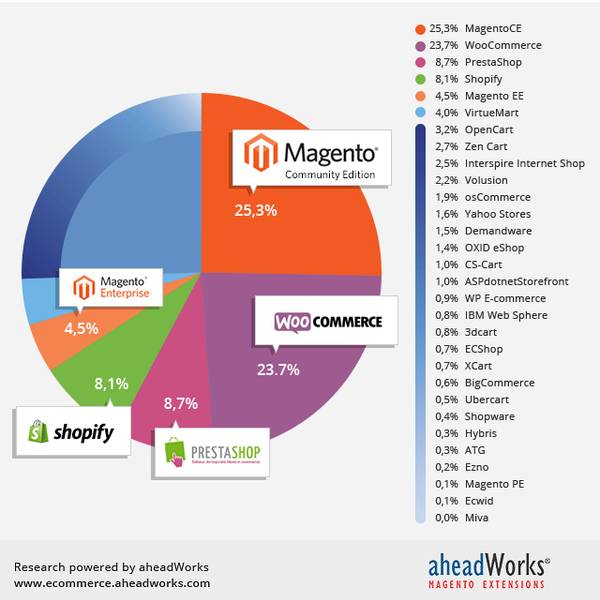
Magento Features
Magento offers all the desirable features to an eCommerce website.
Product Management
- Add the product catalog with multiple product images,
- batch updates,
- manage inventory,
- order management and
- integrate various payment methods
Customer Service
- Customers can create user accounts,
- track shopping history,
- custom forms for customer service,
- Multi currencies, and
- Multilingual
Brand, Marketing and Sales Management
- Integrate Google Analytics account and analyze consumer behavior
- Advanced SEO friendly options
- Integrate marketing promo applications and tools (Coupon codes, promotional offers, etc.)
You can choose and add from 1700 varied functionalities through the Magento-Connect interface.
With free Magento themes, it is easy to set up an online store. However, the prominent question here is, “Will the ecommerce store on Magento platform need security and protection?”
Wondering why Ecommerce Store on Magento Platform Needs Security and Protection?
Though Magento platform offers some brilliant features, it is equally true that repeatedly there have been news of bugs that can lead to serious security breach. Being built on open source code, the platform may have several vulnerability. Popularity of Magento has made it a favorite of hackers and attackers as well.
Earlier the attackers used ‘phishing’ to get breach the security of the eCommerce site. Since the web developers have become aware of the phishing attacks, the hackers now use malvertising as a way to attack the sites that seem secure.
In a latest update, it was revealed that attackers could misuse quite a few vulnerabilities in Magento platform. The leak eventually allows attackers to insert PHP codes on the web server. This flaw is known as remote code execution (RCE). It is inbuilt flaw in the core code of Magento platform. Though a patch for the RCE flaw has been released, yet, over 50 percent of the Magento sites have not updated their sites.
Via RCE flaw, not only the shoppers’ credentials but also the site owners’ privacy is at stake.
11 Ways to secure eCommerce Store on Magento Platform
Though the platform has security functions, they are not enough to discourage the cyber attacks. An eCommerce website needs to take care of their customers’ safety and privacy. Here are a few additional options that you must consider if you believe that your eCommerce store on Magento platform needs security and protection.
1. A Unique Admin Path
Change path of your admin page. It will help your core information stay safe. Instead of keeping your admin login at the default yoursite.com/store/admin make a unique login path such as yoursite.com/store/27AgJ47X
- Access /app/etc/local.xml
- Find “<![CDATA[admin]]>”
- Change word [admin] to [27AgJ47X] or as you prefer
NOTE: Do not ever alter the “Admin Base URL” or its settings stored in admin section. If you alter the Admin Base URL, Magento will not let you access the admin panel.
2. Unique Login Details
With the Brute Force software, the hackers can guess 8 million different combinations of usernames and passwords. Can you beat that? You must have to beat them.
- Keep a unique username and a super complex password.
- Alter your password on regular intervals.
- Do not use the same username and password elsewhere.
It is your duty to keep the attackers at bay and keep the data of your site and visitors safe.
“With websites comes responsibility; with e-commerce websites comes great responsibility.”
Impact of Hack on Magento website
3. Remember your password
Do not store your password in your password manager. The password manager services use the cloud based servers or software. If the attacker hacks your cloud, then your store may be at stake. After all it is on a third party space that you can never ever be a 100 percent sure of.
Risk of theft of the mobile devices i.e. laptop and tablets enhances the risk of vulnerability of the passwords stored in excel sheets as well.
If your eCommerce site can be hacked, your desktop or laptop can be hacked as well.
The best way to keep your passwords safe is to memorize them.
4. Two Step Authentication
Enable a two-step authentication extensions. It will ensure only trusted and registered devices will be able to access the backend of your Magento platform. The two-step authentication generates a random password every 30 seconds. The code is sent to a pre-registered device only. A complex username, a unique password and a code that is sent only to your phone make the window of breach is next to impossible.
5. Static IP Address
Enforce a restricted access to your static IP address. First, ensure that have a static IP and not a dynamic IP. The restriction can be enforced and it requires coding in .htaccess or alternatively, you can use an Apache directive of LocationMatch as mentioned hereunder:
<LocationMatch "admin"> Order Deny,Allow Deny from All Allow from ‘ENTER YOUR STATIC IP HERE WITHOUT THE QUOTES’ </LocationMatch>
Use the admin name to match your admin login page like “admin”, “27AgJ47X” or whatever you have chosen.
If you ever need to access your Magento backend, from a different IP address, you will have first update the LocationMatch directive. It is a bit of extra trouble, but is absolutely worth it.
6. Comply with Latest Version Updates of Magento
Enroll to receive updates about security patches and version updates from Magento. Do not wait to implement the patch or updates. As soon as a new update or patch is rolled out, implement it immediately. Also, update all the additional tools that you use with Magento platform.
7. Updated Anti-Virus Software
Backup and update must be a part of your security checksum. However, if you are lousy in updating your antivirus software, it may cost your ecommerce platform. Schedule your paid antivirus software to update itself every day.
8. HTTPS/SSL Mandatory for Login Pages
Use encryption to on all login pages in Magento with SSL certificate. Enable eCommerce security with trusted SSL certificate and use always-on SSL on every page.
9. Secure Your Email Access
To hack your site, if all the attacker needs to do is obtain your email id mentioned on your LinkedIn profile or hack into your email account to get access of your site, it should be not such a big deal for a processional attacker.
Just make a unique Username and password, similarly use a distinct and secure email id to access your Magento site! Make an email id knottier that is impossible to guess and NEVER use it elsewhere.
10. Use a Secure FTP
Many hackers decode the FTP access and hack the site. Use SFTP along with a Public Key Authentication for utmost secured FTP access.
11. Developers Access
When you need help from outside developers and have to hand over your access to them. Change your access passwords and FTP password. Again, change your access details as soon as the job is over. Do not handover the access to unknown developers. Use trusted organizations with credible background.
A bunch of other things to keep your eCommerce store secured can be taken care of as well. Do not forget to keep yourself in touch with the latest updates. If the need be, hire professional helps if your ecommerce store on Magento platform needs security and protection.

















































































This is Great Wonderful information great post thanks.
Web Design Chennai
Magento as eCommerce player would ever need to be safest in terms of its functional & financial moves. Provided the vulnerability of it to current web threats, the points displayed herein sound pretty accurate. Appreciate!